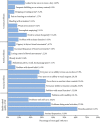Urinary, bowel and sexual health in older men from Northern Ireland
- PMID: 29489050
- PMCID: PMC6220963
- DOI: 10.1111/bju.14182
Urinary, bowel and sexual health in older men from Northern Ireland
Abstract
Objectives: To provide data on the prevalence of urinary, bowel and sexual dysfunction in Northern Ireland (NI), to act as a baseline for studies of prostate cancer outcomes and to aid service provision within the general population.
Subjects and methods: A cross-sectional postal survey of 10 000 men aged ≥40 years in NI was conducted and age-matched to the distribution of men living with prostate cancer. The EuroQoL five Dimensions five Levels (EQ-5D-5L) and 26-item Expanded Prostate Cancer Composite (EPIC-26) instruments were used to enable comparisons with prostate cancer outcome studies. Whilst representative of the prostate cancer survivor population, the age-distribution of the sample differs from the general population, thus data were generalised to the NI population by excluding those aged 40-59 years and applying survey weights. Results are presented as proportions reporting problems along with mean composite scores, with differences by respondent characteristics assessed using chi-squared tests, analysis of variance, and multivariable log-linear regression.
Results: Amongst men aged ≥60 years, 32.8% reported sexual dysfunction, 9.3% urinary dysfunction, and 6.5% bowel dysfunction. In all, 38.1% reported at least one problem and 2.1% all three. Worse outcome was associated with increasing number of long-term conditions, low physical activity, and higher body mass index (BMI). Urinary incontinence, urinary irritation/obstruction, and sexual dysfunction increased with age; whilst urinary incontinence, bowel, and sexual dysfunction were more common among the unemployed.
Conclusion: These data provide an insight into sensitive issues seldom reported by elderly men, which result in poor general health, but could be addressed given adequate service provision. The relationship between these problems, raised BMI and low physical activity offers the prospect of additional health gain by addressing public health issues such as obesity. The results provide essential contemporary population data against which outcomes for those living with prostate cancer can be compared. They will facilitate greater understanding of the true impact of specific treatments such as surgical interventions, pelvic radiation or androgen-deprivation therapy.
Keywords: Life After Prostate Cancer Diagnosis; bowel dysfunction; health-related quality of life; prostate cancer; sexual dysfunction; urinary dysfunction.
© 2018 The Authors BJU International published by John Wiley & Sons Ltd on behalf of BJU International.
Figures


Comment in
-
Re: Urinary, Bowel and Sexual Health in Older Men from Northern Ireland.J Urol. 2019 Feb;201(2):207. doi: 10.1097/01.JU.0000553035.65902.90. J Urol. 2019. PMID: 30634302 No abstract available.
References
-
- Northern Ireland Cancer Registry . Prostate cancer. Available at: http://www.qub.ac.uk/research-centres/nicr/cancerinformation/official-st.... Accessed December 2017
-
- Cancer Research UK . Prostate cancer incidence statistics. Available at: http://www.cancerresearchuk.org/health-professional/cancer-statistics/st.... Accessed December 2017
-
- Glaser AW, Corner JL. Prostate cancer outcomes: the three questions. Eur Urol 2015; 67: 357–8 - PubMed
-
- Rosen R, Altwein J, Boyle P et al. Lower urinary tract symptoms and male sexual dysfunction: the multinational survey of the aging male (MSAM‐7). Eur Urol 2003; 44: 637–49 - PubMed
-
- Coyne KS, Sexton CC, Thompson CL. The prevalence of lower urinary tract symptoms (LUTS) in the USA, the UK and Sweden: results from the Epidemiology of LUTS (EpiLUTS) study. BJU Int 2009; 104: 352–60 - PubMed
Publication types
MeSH terms
Grants and funding
LinkOut - more resources
Full Text Sources
Other Literature Sources
Medical

